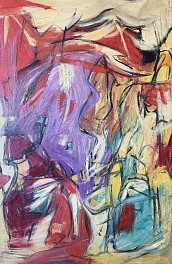BIOGRAPHY

American, 1933-2016
he art market--collectors, curators and museums--is in the early stages of a broad reappraisal of the contribution of previously overlooked groups to the development of post-war modernism. Artists who were regarded on the periphery--because they were women, gay, black or brown--are getting a much-deserved new look as old prejudices crumble.
Judith Lindbloom--young, a woman and openly gay--was one of the many artists who streamed to New York in the post-war years, drawn by the heady atmosphere and freedom to be found. It was not an easy life, especially for a women, because women then were not taken seriously. Yet Lindbloom through herself into the life. Pictures show her cigarette in mouth intently painting. At night she would hang out at the famed Cedar Bar, where she became especially close to Franz Kline.
There was a downside to this Bohemian life--drink and drugs--and Lindbloom indulged too much and too frequently. In 1964, her partner committed suicide and right before she was to be included in a group show at the Whitney, Lindbloom had a breakdown. She would not resume painting for sixteen years.
Judith was a devoted fan of jazz and a muse to many of the greats of the era, including Gil Evans, Sony Rolllins and Steve Lacy. She designed and painted numerous album covers for some of their greatest work.
Her work is included in a new compendium entitled "The Art of Feminism: Images the Shaped the Fight for Equality, 1857-2017."
